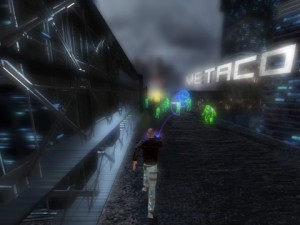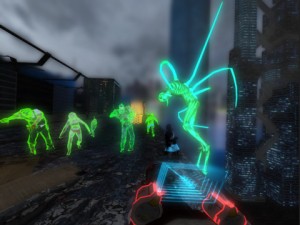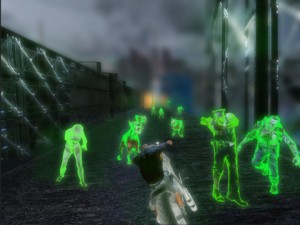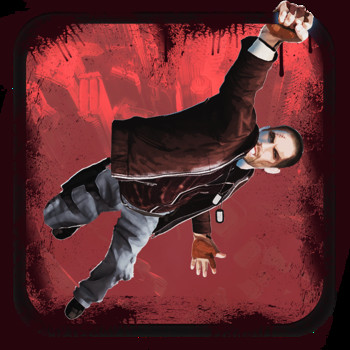Sometime in the future a plague of Radioactive Zombie Ghosts have taken to a neon-filled city’s corporate rooftops, creating a great inconvenience for everyone else still alive (and yet the trains all still seem to be running perfectly on schedule). To be honest, I don’t really understand what’s happening in Getaway – Zombie Plague (out now, $2.99), Gravity Software’s endless runner style mix of House of the Dead meets Mirror’s Edge. There will — however — be plenty enough time to cover the game’s many presentational oddities later on, for now let’s instead begin with how one actually controls the action found within Getaway – Zombie Plague.
 The bulk of Getaway’s actions takes place upon a very standardized — three lane — over the shoulder endless runner setup, with mostly similar controls dictating the hero’s actions. Swiping left or right will cause the hero to switch lanes — as expected — while swiping up or down will cause the hero to leap over chasms, or occasionally slide under the oddly still functional electric fence. Finally, tapping on any of the Radioactive Zombie Ghosts — regardless of the lane they’re currently in — will cause your hero to blast them with his laser pistol thing (after which he’ll often also kick them for good measure).
The bulk of Getaway’s actions takes place upon a very standardized — three lane — over the shoulder endless runner setup, with mostly similar controls dictating the hero’s actions. Swiping left or right will cause the hero to switch lanes — as expected — while swiping up or down will cause the hero to leap over chasms, or occasionally slide under the oddly still functional electric fence. Finally, tapping on any of the Radioactive Zombie Ghosts — regardless of the lane they’re currently in — will cause your hero to blast them with his laser pistol thing (after which he’ll often also kick them for good measure).
Rather than being a true endless runner, Getaway’s levels are primarily a mission based affair (although the game does also contain an optional endless mode) in which a level ends once a fixed objective has been completed. Mission objectives usually either involve running until a specific amount of an object has been collected (such as antidotes), to killing everything for a specific distance, or until a boss monster has been defeated. Players will further receive a score — ranked from 1-to-3 — at a stage’s completion, all based on how many Radioactive Zombie Ghosts they took out by the time the level was finally conquered.
Along the way — outside of the mission type where specific items are needed to succeed — players can also find other useful items laying about, such as health-kits — ammo crates — and various limited time special weapons. The ammo crates are perhaps the most vital to a player’s success, as players will constantly be faced with a screen jam packed with an endless horde of the aforementioned Radioactive Zombie Ghosts. Although the rare health kits are — even if the player is genuinely good at Getaway — perhaps the most vital item of all, but I’ll cover this facet of the game’s frustrating cheapness further down.
 The game’s other mission type is one where the player takes control of an unlimited ammo chain gun placed on top of a rooftop, wherein they can drag their finger across the screen to aim the gun anywhere they please within a full half-sphere range. There will also usually be a giant looming boss monster in the background that must be defeated, but not at the cost of permitting any of the surrounding horde to reach the player’s position. In order to let players know when the boss is about to do something- – such as tossing a giant fart-hadouken at their position — an exclamation mark will appear whenever the boss is attacking, so that players may otherwise spend their time battling the minion masses.
The game’s other mission type is one where the player takes control of an unlimited ammo chain gun placed on top of a rooftop, wherein they can drag their finger across the screen to aim the gun anywhere they please within a full half-sphere range. There will also usually be a giant looming boss monster in the background that must be defeated, but not at the cost of permitting any of the surrounding horde to reach the player’s position. In order to let players know when the boss is about to do something- – such as tossing a giant fart-hadouken at their position — an exclamation mark will appear whenever the boss is attacking, so that players may otherwise spend their time battling the minion masses.
It also these turret sections where one of my largest complaints with Getaway — Zombie Plague lies, as they always leave the player ready to die of boredom long before either the boss or the hero succumbs. The problem is that while the chain gun can only ever do piddling weak damage to the boss, whom has a very large health bar, they can never focus on him because otherwise the infinite surrounding horde will take out the player. By the time a player has spun their gun around in a full circle for the third time — always moving slowly, lest their reticule misses something — they’re just about ready to fall asleep, which they’re deathly afraid of doing as that would mean restarting the mission.
The over all prevailing sense of boredom — however — isn’t just limited to the occasional turret sections, it is basically a running issue found throughout the entirety of Getaway’s experience. Every single level in the game is guaranteed to run long past the point at which the player was already ready for the action present to just end, and there are numerous potential reasons for this that I plan to cover in detail. Perhaps the chief issue here is that although the game borrows heavily from the mechanics of popular 3D endless runners, it implements those rules poorly (leading to failures that always feel cheap).
 Normally in a 3D endless runner it will be assumed that if you either jump over an enemy — or move to a different lane — that the end result should be your safety, but here it will almost always end in your failure. Apparently the Radioactive Zombie Ghosts were all former NBA stars, as they will always jump up to catch you — which is impressive, since you regularly leap over to far away buildings — and will then pull you back down to them. The lane changing — on the other hand — fails because the zombies all seem immune to the “lane restricted movement” law that you yourself are bound to, and will reach out to grab you if you’re not at least two lanes away (and there’s always zombies in every lane).
Normally in a 3D endless runner it will be assumed that if you either jump over an enemy — or move to a different lane — that the end result should be your safety, but here it will almost always end in your failure. Apparently the Radioactive Zombie Ghosts were all former NBA stars, as they will always jump up to catch you — which is impressive, since you regularly leap over to far away buildings — and will then pull you back down to them. The lane changing — on the other hand — fails because the zombies all seem immune to the “lane restricted movement” law that you yourself are bound to, and will reach out to grab you if you’re not at least two lanes away (and there’s always zombies in every lane).
Ideally the game actually intends for you to shoot each and every last one of these undead ethereal isotope harbingers of doom, which — as I mentioned previously — is done by directly tapping each and every zombie individually. The problem here is that the screen is always filled with zombies — all of whom are small and hard to hit — and you furthermore have limited ammo, and you likely won’t live to reach more if you run out. This problem then goes into overdrive on the running stages where bosses harass you, as you’ll want to rapidly fire at the boss — to end the game’s overblown boringness — yet won’t be able to as the appearance rate of ammo crates are always randomly controlled.
Sadly — even if you do manage to handle the frenzied, yet boring, shooting that Getaway constantly demands without reprieve — the game’s artwork is perhaps an even worse still problem for players to deal with. Although Getaway’s graphics might look nice at first glance, the game quickly turns into a real-time demonstration of why it’s often a very bad idea to build an art scheme entirely based around black on black motifs. Whereas most endless runners will let players see obstacles coming in from far away, the only reason you’ll often know where you should jump and/or slide here is because of blinking arrows.
 This problem is then complicated by the fact you will usually miss the presence of these arrows — which seem to start blinking at the last second — as you were otherwise dealing with shooting the eternal Radioactive Zombie Ghost horde, always one minion at a time. This will end with you commonly slamming head first into an oncoming blackened fence that you never knew was there until you plowed into it face first, all because someone thought black scenery at night time would be a good idea. Worse yet, assuming you do make the jump/side, you’ll often be unjustly attacked before the maneuver ends — during which time you can’t fire back — by a zombie that wasn’t there yet when you first evaded.
This problem is then complicated by the fact you will usually miss the presence of these arrows — which seem to start blinking at the last second — as you were otherwise dealing with shooting the eternal Radioactive Zombie Ghost horde, always one minion at a time. This will end with you commonly slamming head first into an oncoming blackened fence that you never knew was there until you plowed into it face first, all because someone thought black scenery at night time would be a good idea. Worse yet, assuming you do make the jump/side, you’ll often be unjustly attacked before the maneuver ends — during which time you can’t fire back — by a zombie that wasn’t there yet when you first evaded.
In fact, if you play very close attention, it will slowly become clear that — despite all appearances — you’re not actually dealing with an ethereal horde of Radioactive Zombie Ghosts. Shooting any of the game’s relentless horde will both kill that zombie and strip their ridiculous glowing off in the process, which — if you have good vision — will let you see their solid body fall to the ground. The reason all of the enemies are glowing like Chernobyl victims is because they’re just as black as all the game’s other graphics, and — rather than having good color balance — this was how the developer made them all visible.
Unfortunately the use of glowing graphics didn’t do enough for Getaway – Zombie Plague to enable some of the game’s obstacles to be properly dodgeable, such as the game’s ultra annoying moving energy barriers. These fences — the same as the glowing zombie horde — aren’t bound to the same movement rules that you yourself are, making it extremely hard to determine how to avoid them (without them ramming into your side). Wherever they are when you begin approaching them isn’t where they’ll be the moment you try to cross their space, and calculating where you need to be — with them whizzing quickly back and forth — is not something you can do alongside your frenzied shooting.
That’s nothing to say of the fact that you’ll quickly begin to wonder how, if this is truly a zombie apocalypse, there’s still enough power to keep energy fences running upon every rooftop everywhere. I get that with the occasional fifty foot tall super zombies, the colossal bat creatures — and other such bizarre abyssal creations — that Gravity Software probably hoped to invoke the visual motif of House of the Dead. However — with no explanations given at any point time — none of this will ever make one lick of sense, especially when futuristic fighter jets start showing up to air drop more zombies on you.
Ultimately, other than the fact that there are no IAPs in Getaway, it’s simply too hard to recommend a game riddled by obscured graphics — constant cheap shots taken upon the player — and levels that constantly run on towards the point of mind numbing boredom.
iFanzine Verdict: Although a game about parkour hopping across roof tops — played out in an endless runner style motif — with House of the Dead style abominations might seem fun at first, there simply isn’t much of anything resembling fun to be found here. All of the levels are extremely long — filled with action that is never engaging, only tedious — and usually if you die to a Radioactive Zombie Ghost it will be largely due to a variety of cheap shots (rather than your own personal carelessness). Coupled with all of this are graphics so dark that you can usually only see things if the developer has made them glowing, or by pointing them out with arrows, further dampening the mood.


